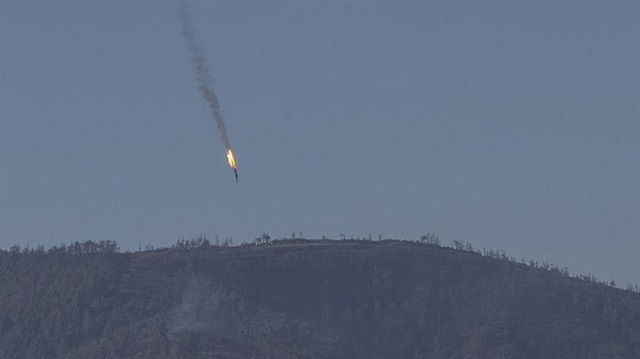
Russia has a long history of violating airspace and territorial waters as a means of applying pressure to achieve political aims.
On Tuesday, Turkish forces shot down an unidentified bomber which Russian authorities claimed was a Russian SU24 fighter jet. The jet had violated Turkey's airspace according to a radar tracking diagram provided by the Turkish Chief of General Staff.
U.S.-led anti-Daesh coalition spokesman Col. Steve Warren said coalition headquarters heard the incident on radar and confirmed Turkey's military claim regarding the lack of response from the Russian pilots. The pilots were warned 10 times in 5 minutes, according to the Turkish Armed Forces.
The Turkmen Mountains region, near where the plane was downed, has been targeted by Russian air strikes as part of a heavy bombing campaign against targets in northern Syria.
There have been two previous incursions by Russian aircraft into Turkish airspace this year, one on Oct. 3 and one on Oct 4. Each time Turkish F-16 jets intercepted the Russian fighters forcing them to turn back. Turkey has formally protested against the incursions.
Turkish and Russian officials met five times in October to discuss the airspace violations. At these meetings, Turkish officials reminded their Russian colleagues of the rules of engagement that Turkey had adopted regarding its airspace.
“But Russia's strategy is aggressive and risky,” Italian foreign policy analyst Maurizio Molinari said. “Russia is seeking leverage for a tough bargain with the West on Syria, and on the survival of the Assad regime.”
NATO officials have reported a list of violations by Russian military aircraft trespassing in European airspace. According to those statistics, there were six incidents with Estonia, three with Finland, and one each with Denmark and Poland. Against Sweden there were ten in 2014, up from eight in 2013, and seven in 2012. While there were no violations of Latvian airspace, there were over 180 incidents in which the Russian air force flew close to the borders in 2014. The Russian intruders turned off their transponders, electronic devices most aircraft are required to operate to make it easy to track them, in nearly all of the cases.
NATO fighters policing Baltic airspace were scrambled 68 times along Lithuania's borders [in 2014], by far the highest count in more than 10 years. Estonia has said its sovereign airspace had been violated by Russian aircraft five times this year.
Tactics typically deployed by Russian pilots include a practice of deliberately failing to report flight plans, ignoring civilian air traffic controllers and switching off their on-board transponders that NATO Secretary General Jens Stoltenberg referred to as "flying dark" an approach which he said was inherently unsafe and poses a serious risk to civilian air traffic.
“Russia is seeking to 'neutralize' Sweden in the political and military sense. Its aggressive actions are intended to demonstrate Russia's overwhelming military capabilities and emphasise the glaring gaps in Sweden's defense system, and thus intimidating the public and influencing decision makers in Sweden and throughout the Baltic Sea region. This activity is so far part of the psychological war Russia is carrying out in the region. Its purpose is to influence Swedish security and defense policy, the direction of which – due to the country's geographical position – is of essential importance for the security of the entire Baltic Sea region,” wrote Justyna Gotkowska, researcher for Poland's Centre for Eastern Studies, in a report published in October 2014.
According to a report by European Leadership Network (ELN) published in November, the strategy can work for Russia, which uses such incidents to observe patterns of response and to test the preparedness of specific elements of individual nations as well as their alliance with NATO and other partners.
Russia also seeks to warn countries in its neighborhood that any steps taken towards integrating with Europe or seeking NATO membership would lead to further Russian harassment, according to the report. Such incidents are also meant to undermine confidence in NATO, demonstrating that the defense alliance would not be able to organize swift support for these countries. Moreover, these actions are “intended to send a message of deterrence by demonstrating Russia has both means and willingness to confront NATO and U.S. forces.”
Following increased tensions over Ukraine between Russia and NATO, there was an increase in Russian planes flying into NATO airspace and submarines venturing into its waters. Britain and other NATO members stepped up air policing missions as the number of interceptions over the Baltic States rose to 15 in 2014, the Telegraph reported on May 15.
In 2014, Finland claimed five violations of its air space by Russian warplanes, RFE reported on June 27, citing Reuters and TASS.
Last winter, the Swedish Defense Minister complained about Russian military aircraft flying close to a Swedish commercial airliner with its transponders turned off, DW reported on Dec. 15. This spring, the semi-official Sputnik agency boasted of Russian jets penetrating NATO ships' defenses in the Black Sea on March 4.
In autumn, four incidents were reported, one in Swedish airspace, the other in Swedish waters involving a Russian submarine, besides two other incidents of violation of airspace of Latvia and Norway.
In Sept 2014 the Swedish foreign minister lodged a formal complaint with the Russian ambassador after two jets flew close to the Swedish island of Oland. Last March, following the sighting of a Russian submarine, the Swedish government announced plans to supplement and upgrade the ships and underwater surveillance systems it uses to detect foreign submarines in its waters.
Polish researcher Andrzej Wilk wrote in September 2014 that the European part of Russia and the Arctic are witnessing other large-scale exercises by the Russian Federation's armed forces, and their involvement in the conflict in Ukraine is also continuing. In total, these armed exercises involve over 200,000 soldiers and several thousand combat vehicles, hundreds of planes and helicopters, and about a hundred ships. Wilk also observed that “the increase in the Russian army's activity and military spending is coupled with an information campaign which is becoming increasingly intense, which maintains that Russia must defend itself against Western aggression. In the near term, Wilk predicted, that “it should be assumed that the principal objective of Russia's clear demonstration of power is to exert pressure on the West, to force it to make further concessions on the issue of Ukraine and to confirm the Russian Federation's position as a superpower.”
According to one Western official, there has been a threefold increase in quick reaction alerts – the scrambling of fighter jets – because of Russian activity in the vicinity of alliance airspace reaching well over a hundred between January to September 2014. According to the Pentagon, in the two months from August to September 2014 alone, Russian nuclear bombers have made at least 16 incursions into U.S. and Canadian air defence identification zones. Two incursions –on Sept. 17 and Sept. 18 – coincided with the visit of Ukrainian President Petro Poroshenko to Ottawa and Washington.














